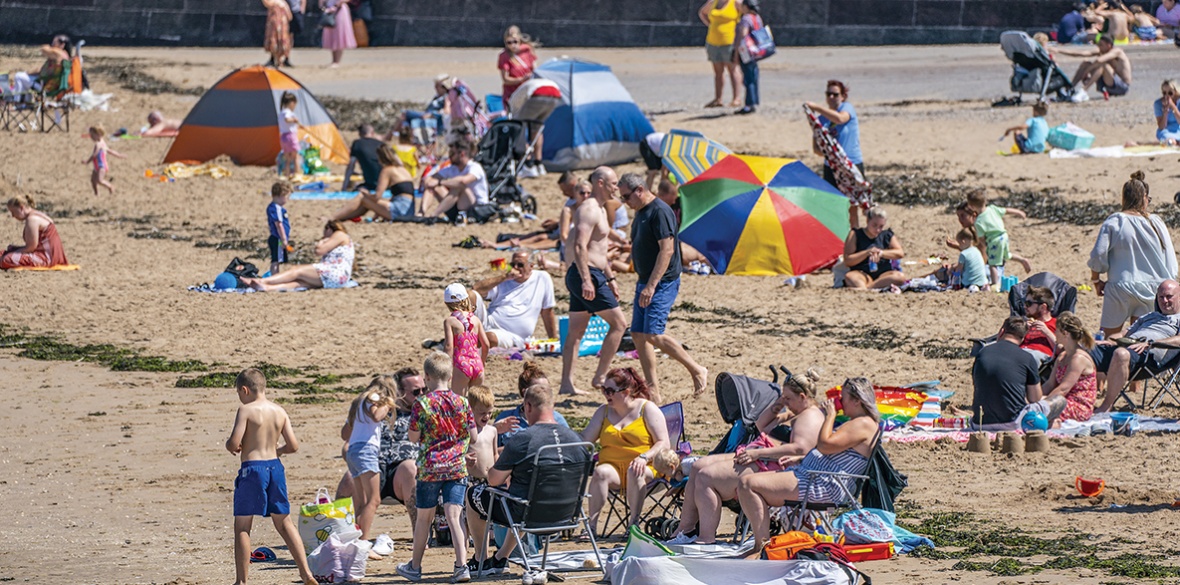This is the last article you can read this month
You can read more article this month
You can read more articles this month
Sorry your limit is up for this month
Reset on:
Please help support the Morning Star by subscribing here
THE current spell of hot weather in Britain has led to the Met Office issuing its first ever “extreme heat warning.” Aside from the damaging effects of the heat, another danger of sunny weather is ultraviolet radiation (UV).
UV damages the skin, leading to sunburn and potentially to skin cancer. The form of cancer most associated with sun damage is melanoma, where melanocytes (skin cells which produce pigment) begin uncontrolled growth, forming tumours that start shallow but can spread to the rest of the body.
Increases in temperature such as we are currently enduring have no direct effect on the risk of sunburn. However, clear skies that are free of clouds to absorb some of the UV radiation and the urge to spend more time outdoors soaking up the rays both contribute to a greater risk of high UV exposure.
As well as temperature, the Met Office also issued a forecast with the UV index. This index accounts for cloud cover and also amounts of ozone in the stratosphere, both of which usually block amounts of UV.
A cloudless sunny day in high summer, such as we have seen recently, is one of the most dangerous times for melanoma. Those at most risk of melanoma are overwhelmingly those with less pigment in their skin. According to Cancer Research UK, an instance of sunburn once every two years can triple the risk of melanoma.
Sunburn may seem mild compared to skin cancer, but the root cause is the same. Sunlight contains photons of ultraviolet radiation, which are so energetic that they can directly change the DNA inside living cells. Usually DNA is formed of two strands that are joined together to form a twisting double helix, but a photon can provoke two letters of thymine (denoted “T”) in the same strand to form a bond. This creates a bulge in the normally very regimented DNA double helix pattern that causes problems when it is later replicated as part of the cell regeneration process.
UV also damages other parts of cells other than DNA. When the cells start to become damaged, this provokes an inflammatory response which we call sunburn.
This is a visible sign that the DNA inside the cells has been punctured by ultraviolet photons – photons which have travelled from the Sun, across the vacuum of space, through the ozone layer, down through the atmosphere, and into the skin, to unload their energy inside the body.
Skin cells exposed to sunlight are under constant attack. Fortunately they have many defence mechanisms to near-instantly correct this damage, but of course sometimes an error gets through. If these errors occur in certain genes, they can produce uncontrolled growth of the cells – what we call cancer.
UV radiation is not the only thing which can damage our DNA. Many things damage our DNA, and they do so in different ways depending on the underlying chemistry of how they provoke changes in the DNA molecules. These differences show up as characteristic patterns of changes in DNA. For example, the impact of tobacco smoke on DNA is different to the impact of sunlight.
Any one person’s genome changes over their lifetime in different cells of their body, as mutations accumulate. In a cancerous cell, some of these mutations have caused it to grow and multiply abnormally, resulting in an unhealthy abundance of that cell’s descendants: a tumour. The genome of the cancerous cell will contain the key mutations that caused this growth, but also other mutations, accumulated junk that didn’t get filtered out but has remained there through the descendants.
This set of mutations contains information about the cell’s ancestors. It is like a fossil record of what happened to them over the years, but one where the fossils are all presented mixed up together.
Solving the puzzle of what caused the set of mutations means working out what combination of different carcinogens would be consistent with the patterns.
Rather than finding a single fingerprint at a crime scene, it is more like finding a complex set of overlapping fingerprints. This set of patterns must be deconstructed to work out how much each of the culprits contributed to the crime.
Over the past decade, there has been remarkable progress in identifying such “mutational fingerprints” and then identifying them to different cancer-causing environmental exposures or substances.
By looking at cancers associated with different causes, one can begin to map the cause to the fingerprint. For example, because the mechanism by which UV causes damage is letters of T bunching together, UV’s fingerprint is lots of changes from T.
In contrast, tobacco smoking has very few of these mutations but causes a high number of mutations between the letters C and A.
The methods to identify fingerprints can even identify characteristic fingerprints that are seen in cancers across the world, but where the cause of the fingerprint is not known.
Some of these causes will be external, such as tobacco smoke or UV, and some will be internal, such as the intrinsic error rate of the cell’s own replication machinery (no biological machine is perfect).
This combination of genome sequencing and statistics is fascinating for what it tells us about the natural history of cancer. We can read the history of someone’s cells and understand what led the tumour’s ancestor through the garden of forking paths of mutation to become cancerous.
The internal causes show us that there are many forms of cancer we can’t stop. But there are some we can. Apply sunscreen and wear a hat!









